|

|
|
|
Maturation of the oocyte in the dominant follicle shortly before ovulation
|
|
|
|
Review: The primary oocyte
|
|
|
In the first week of the cycle the maturation of the oocyte in its associated follicle depends on the progress of the maturation of the surrounding follicle cells. The fittest follicle with its oocyte becomes the dominant follicle in the second cycle week and, later, a graafian follicle (Fig. 9).
Up to just under two days before ovulation, the maturation of the oocyte consists in its ingestion of substances (growth of the yolk) that are supplied by the surrounding granulosa cells. This exchange of substances is mediated through cytoplasma processes of the granulosa cells that are anchored through the pellucid zone at the oocyte surface (Fig. 10). The oocyte nucleus [2n, 4C] is also matured in the last days before the LH peak. Up to that point it was arrested in the extremely elongated prophase (= dictyotene) of the first meiosis (the arrested condition that has existed since the fetal period). Through the «maturation» the nucleus changes in the diakinesis (of the prophase) and prepares itself for the completion of the first meiosis, which is triggered by the LH peak.
|
|
|
Commentary
|
|
How do hormonal factors influence the follicle in its maturation process?
For this, see the picture sequence
« What causes the LH peak?» (620 kB) on the previous page.
|
|
|
| Fig. 9 - Graafian follicle |
|
Fig. 10 - Primary oocyte |
|
Legend |
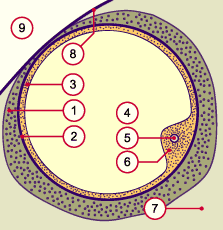
1
2
3
4
5
6
7
8
9
|
Theca interna and externa
Basal membrane between theca
and granulosa
Granulosa
Graafian follicle with follicle fluid
Primary oocyte
Cumulus oophorus
Ovarian tissue
Tunica albuginea of the ovary
Abdominal space |
|
|
|
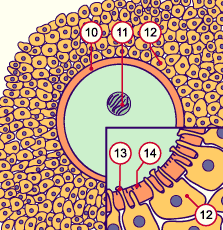
10
11
12
13
14
|
Pellucid zone
Nucleus in the diakinesis stage
Granulosa cells
Processes of the granulosa
cells
Microvilli of the oocyte surface |
|
|
|
Fig. 9
Depiction of a graafian follicle just before the LH peak:
The granulosa cells surround the primary oocyte (5) in a compact form called the cumulus oophorus (6). The current size of the oocyte corresponds to the size of the dot of the "i" in this text.
Fig. 10
A cut through the cumulus oophorus to visualize the primary oocyte. The cell processes (13) of the granulosa cells (12) supply the primary oocyte through the pellucid zone (10). The nucleus has entered the diakinesis stage.
|
With the LH peak the following maturation steps are now triggered in and around the oocyte - up to ovulation:
|
|
|
|
|
|
Termination of the first meiosis
|
|
|
The spindle apparatus for dividing the chromosomes has formed and oriented itself radially to the cellular surface. The first polar body will arise at the spot where the spindle apparatus is anchored on the cellular surface. Further, the processes of the granulosa cells have retracted from the oocyte surface into the pellucid zone. They have released themselves from the oocyte and this leads to the formation of the perivitelline space. In this space the ejection of the first polar body takes place as a sign that the first meiosis has ended.
|
|
|
| Fig. 11a - Terminating the first meiosis |
|
Fig. 11b - Ejection of the first polar body
- secondary oocyte - |
|
Legend |
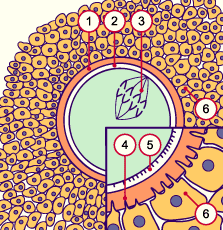
1
2
3
4
5
6
|
Pellucid zone
Perivitelline space
Spindle apparatus in the anaphase
of the first meiosis
Granulosa cells retract their cell
processes
Microvilli of the oocyte surface
Granulosa cells |
|
|
|
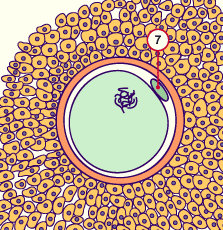
|
|
Fig. 11a
Diagram showing the situation 15 hours after the LH peak. The spindle apparatus for the division of the chromosomes has formed and oriented itself radially to the cell surface. The granulosa cell layers are partly loosened. In the enlargement the retraction of the granulosa cell processes and the appearance of the perivitelline space are illustrated.
Fig. 11b
Freshly generated secondary oocytes with the first polar body (18h).
|
| With the end of the first meiosis the name of the oocyte changes from primary oocyte to secondary oocyte. |
|
|
|
|
| Through the effects of LH on the granulosa cells, these have begun to loosen their cellular bonds and to multiply. They now also produce progesterone that is released into the follicle fluid. Through the separation of the homologous chromosomes in the first meiosis a haploid (reduplicated) set of chromosomes (1n, 2C) is now to be found in the secondary oocyte. The first polar body also contains 1n, 2C. Via a fine cytoplasmic connection the polar body and oocyte remain bound together following the meiotic division, similar to what takes place when male gametes are formed. |
|
Fig. 12 - secondary oocyte |
|
Legend |
|
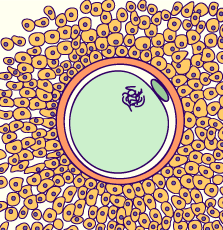
|
|
Fig. 12
The situation 21 hours after the LH peak:
the granulosa cells have loosened up considerably.
|
|
The role of progesterone in the follicle fluid
|
|
According to present knowledge, progesterone has the following two main tasks in the follicle fluid:
- It stimulates the further maturation of the oocyte
- During ovulation it enters the fallopian tube and guides the formation of a concentration gradient for attracting the sperm cells.
|
|
|
|
|
|
The follicle that is about to rupture
|
|
|
Besides the hormones, the granulosa cells also secrete an extra-cellular matrix, mainly hyaluronic acid, into the follicle fluid. Before ovulation the follicle fluid volume increases markedly. The cumulus cell bonds loosen further. In this way, together with the enclosed oocyte, they free themselves from where they were attached to the follicular wall and now swim in the follicle fluid. The wreath of granulosa cells that enclose the oocyte is called the corona radiata.
|
|
|
Fig. 13 - Follicle about to rupture
Oocyte surrounded by a cloud of cumulus cells (corona radiata) |
|
Legend |
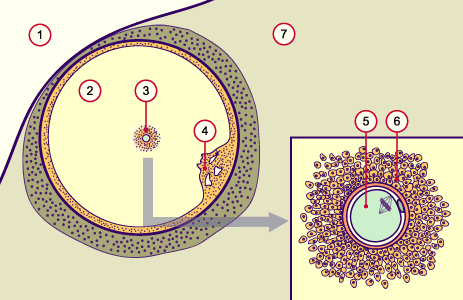
1
2
3
4
5
6
7 |
Peritoneal cavity
Follicle about to rupture with follicle fluid (containing lots of hyaluronic acid
and progesterone)
Cloud of cumulus cells with oocyte
Loosened-up cumulus cells
Secondary oocyte
Corona radiata
Ovarian tissue |
|
|
|
Fig. 13
How things look 35 hours after the LH peak. The oocyte swims in a cloud of cumulus cells in the follicle fluid. The follicle bulges out the ovary's surface. The true size of the oocyte in the follicle corresponds to the dot on an "i" in this text.
|
The oocyte has now ended all the steps of maturation that were set into motion by the LH peak. The molecular and structural preparations for the time following the penetration by the sperm cell have now been made in the cytoplasma. A spindle apparatus (2nd meiosis) has again been able to form with the chromosomes in the equatorial level (metaphase plate). The spindle is once more anchored radially to the cell membrane near the polar body. The same processes of spindle formation also take place in the polar body.
The second meiosis is arrested in this position. The final steps of the maturation, namely the freeing for the second meiosis, are first completed by the secondary oocyte when the spermatozoon has penetrated the oocyte. |
|
Fig. 14 - Secondary oocyte in
metaphase 2 |
|
Legend |
|

1
2
3 |
Spindle apparatus with
chromosomes that form the
metaphase plate
Arrested spindle apparatus in
the polar body
Perivitelline space |
|
|
|
Fig. 14
Oocyte and polar body arrested in the metaphase of the second meiosis (the existing remaining cytoplasmic bond between oocyte and polar body is recognizable in the enlargement).
Polar bodies degenerate with time.
|
|
The follicle and the oocyte are now ready for ovulation that takes place roughly 38 hours after the LH peak.
|
|
|
|
|

